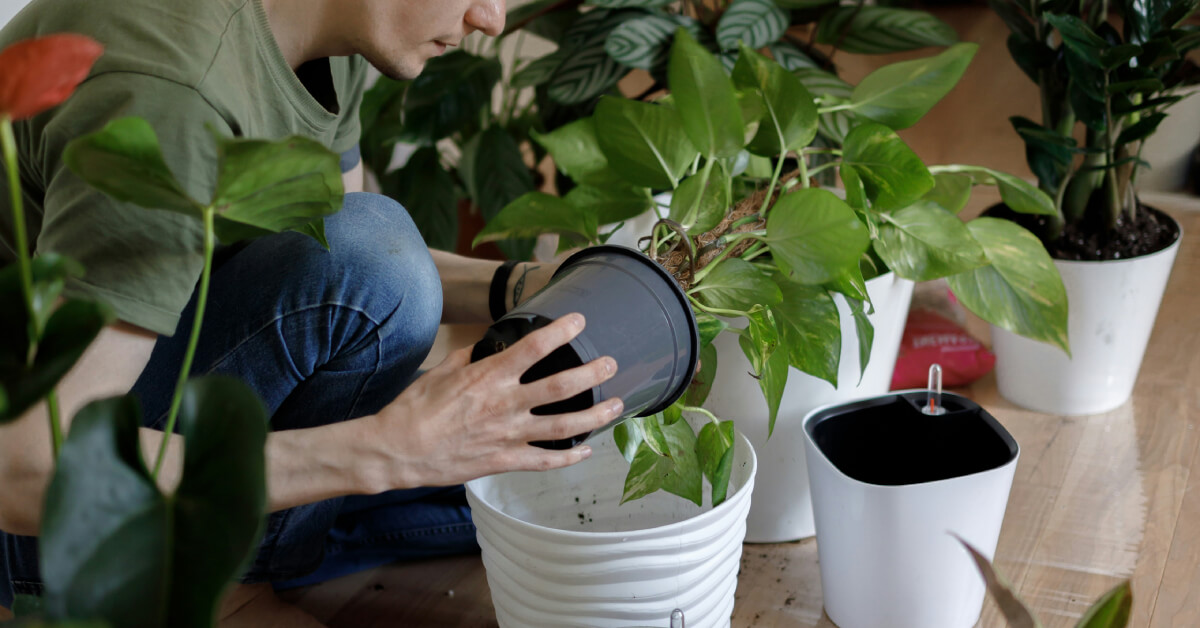Choosing the right pot is just as important as watering and light when it comes to plant health. The wrong pot can lead to root rot, slow growth, or drainage issues, while the right one will help plants thrive, develop healthier roots, and grow beautifully. This guide explores how to select the best pot size, materials, and drainage options for your houseplants to ensure they stay healthy and vibrant.
Why the Right Pot Matters for Indoor Plants
The choice of pot directly impacts the health of your plants. A well-chosen pot prevents several common plant problems. For example, a pot with good drainage allows excess water to escape, preventing root rot—one of the most common plant issues. The right pot size supports healthy root growth, ensuring roots have enough space to expand without being cramped. Stability is another key factor; heavier pots help support top-heavy plants and prevent them from tipping over, especially as they grow. Finally, the right pot enhances the aesthetics of your home, adding style and charm to your décor while showcasing your plants at their best.
How to Choose the Right Pot Size
Selecting the correct pot size is critical to preventing overcrowding and ensuring proper drainage. If a pot is too small, the plant’s roots can become cramped, leading to slow growth and potentially root rot. Conversely, a pot that’s too large can hold excess soil that retains too much moisture, creating conditions for waterlogging and root rot.
A general guideline is to choose a pot that’s about 1-2 inches larger than the current root ball of the plant. For example, small houseplants like succulents or herbs typically need pots that are 4-6 inches wide, while medium plants like Pothos or Peace Lilies do well in 6-10 inch pots. Larger plants like Fiddle Leaf Figs or Rubber Plants need pots that are at least 12 inches in diameter. Be sure to repot plants every 1-2 years as they grow to ensure they have enough space and fresh soil.
Best Materials for Plant Pots
The material of the pot you choose can influence both plant health and aesthetics. Here are some of the most popular options:
- Terracotta (Clay) Pots: These are a classic choice, particularly for succulents, cacti, and snake plants, which prefer dry conditions. Terracotta pots are breathable and help prevent overwatering, but they dry out quickly and can crack in cold temperatures.
- Plastic Pots: Lightweight and affordable, plastic pots retain moisture well and are often ideal for tropical plants and moisture-loving species. However, they are less breathable than terracotta and can trap excess water if not monitored carefully.
- Ceramic (Glazed) Pots: Known for their aesthetic appeal, ceramic pots are durable and can retain moisture. However, they are heavier and more expensive, and some may not come with drainage holes, which can lead to drainage issues.
- Fabric Grow Bags: These are an excellent option for temporary plant housing, herbs, or vegetables. They allow air pruning of roots and provide good drainage, though they require more frequent watering and are less decorative than traditional pots.
Drainage: The Most Important Factor in Pot Selection
Drainage is crucial to a plant’s health. Without proper drainage, excess water can build up in the pot, leading to root rot—the number one cause of indoor plant death. Always choose pots with drainage holes to allow excess water to escape. If you prefer a decorative pot that doesn’t have drainage holes, place a plastic nursery pot inside the decorative pot to ensure proper drainage. You can also add a layer of gravel or pebbles at the bottom of the pot to improve drainage.
Additionally, using a saucer under your pot to catch excess water is essential. However, never let the plant sit in standing water, as it can cause the roots to suffocate and rot.
Choosing the Right Pot Shape
The shape of the pot matters because different plants have different root systems. For example, tall and narrow pots are best suited for deep-rooted plants like snake plants, while wide and shallow pots are ideal for shallow-rooted plants like ferns or succulents. For trailing plants, such as Pothos or String of Pearls, hanging baskets are a great choice, as they allow the plants to cascade down naturally.
Should You Use Self-Watering Pots?
Self-watering pots are designed to store water in a built-in reservoir, gradually hydrating the plant as needed. These pots are great for people who may forget to water regularly, keeping the soil consistently moist. However, they are not ideal for plants like succulents or cacti, which prefer dry conditions. If using a self-watering pot, monitor the moisture levels carefully to prevent overwatering, which can lead to root rot.
How to Repot a Plant into a New Pot
Repotting is an important part of plant care, ensuring that your plant has enough space to grow and fresh, nutrient-rich soil. Here’s how to do it:
- Choose the right-sized pot (1-2 inches larger than the current pot).
- Prepare fresh soil suited for the plant type (e.g., cactus mix for succulents, peat mix for tropical plants).
- Gently remove the plant from its old pot, loosening any tangled roots.
- Place the plant in the new pot, filling in with soil around the roots, leaving space at the top.
- Water thoroughly, allowing the excess water to drain out.
It’s best to avoid repotting during the plant’s dormancy (winter), as this is when the plant grows more slowly and may struggle to recover.
The Perfect Pot for a Thriving Plant
Choosing the right pot is essential to your plant’s health. Whether you prefer terracotta for succulents, plastic for moisture-loving plants, or self-watering pots for convenience, the right choice ensures your plants remain healthy and thrive. By selecting the right pot size, material, and drainage option, you’re setting the stage for a flourishing indoor garden that adds beauty and life to your space.

